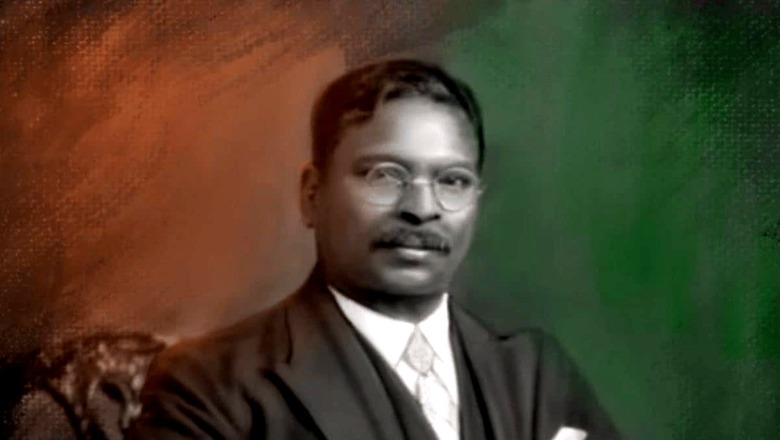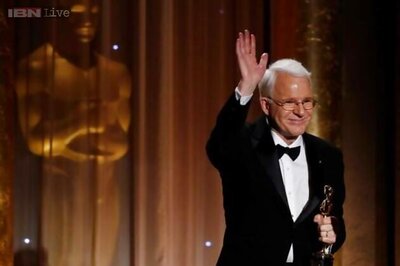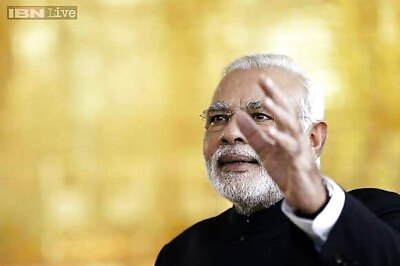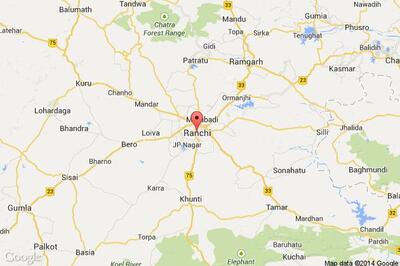
views
The title of this article is a reference to a study by a ‘foreign’ scholar about the Dalit movement in India. The author introduces M.C. Rajah as a Hindu Mahasabha Dalit, a sort of ‘mild’ slur akin to the modern-day moniker ‘Sanghi.’
Rao Bahadur Mylai Chinna Thambi Pillai Rajah, better known as M.C. Rajah, was one of the foremost Dalit voices of Bharat. He was born on June 17, 1883, in Chennai. He attended Wesley Mission High School in Royapettah, Chennai, and graduated from the Madras Christian College. He finished his teacher training course at the Saidapet Teacher Training College in Chennai and worked as a school teacher, and later a college professor.
M.C. Rajah was a great orator, debater and a sportsman par excellence. He captained the Madras Christian College cricket team and was also a very gifted tennis player. He was the first Dalit leader in the Provincial Legislative Council (1919) and the Central Legislative Assembly (1925). He was a prolific scholar, a teacher of teachers, and, of course, the foremost advocate for equal rights for Dalits.
Presenting the title of Rao Bahadur to M.C. Rajah, the Collector of Madras on December 15, 1922, remarked, “You are such a well-known public man that it is almost unnecessary for me to say much about you. No doubt you have received this title because of the work you have done for and the esteem in which you are rightly held by the members of your own important community of the Adi Dravidas. During the labour troubles, you did yeoman service in restraining from violence and in protecting them effectively from lawbreakers.
You have represented your community in deputations to the Right Honourable Secretary of State and to His Excellency the Viceroy. You are the first Adi Dravida to enter the Legislative Council and you have the interests of the depressed and poor always at heart.”
Teacher of teachers
The readers will be pleasantly surprised to learn that M.C. Rajah, along with R. Ranganayaki Ammal, authored a book called Kindergarten Room. This book is a compendium of nursery rhymes, games and riddles which includes the most famous Tamil nursery rhymes such as Kai Veesamma Kai Veesu, Nila Nila Odivaa, Saindhaadamma Saindhaadu, and Kaakka Kannukku Mai Kondu Vaa.
M.C. Rajah was your quintessential guru — not just a teacher but someone who brought clarity to your mind. His magnetic methods could pull even the students from the last bench forward. He was as good an administrator as he was a teacher. In 1917, he was appointed by the then Governor of Madras Province, Lord Pentland, to the committee that looked into elementary education in the province. Subsequently, he was drafted into the general body, which drafted the Elementary Education Policy. He was appointed to the Senate of Madras University in 1924 by Lord Willingdon. Along with T.S. Ramaswamy Iyer, he started the first government-approved free hostel for students from depressed classes. He was also a champion of the Scout movement. As the Director of the Scout movement in the Madras province, he was instrumental in spreading the Scout and Guide movement across the province.
M.C. Rajah and his politics
This was the time when Bharat faced two issues regarding Dalits and the depressed class: (1) the colonial masters were working from within and outside to remove the depressed classes from the Hindu fold, make them a separate block, and therefore control the nationalist upsurge, and (2) society needed to be reformed and cleansed of practices like untouchability, and the oppressed classes had to be mainstreamed. M.C. Rajah was someone who not only understood the gravitas of the need to address both these points but also how these two points were intertwined.
The British played this politics of numbers at various levels. At the time of the first decennial Census in 1871-72, they were ‘obsessed’ with the question of whether the untouchables could be classified as Hindus. Though this question dragged on, there clearly was a guideline to mark them separately. They were instructed “to enumerate the castes and tribes returned or classed as Hindus who do not conform to certain (religious) standards or are subject to certain disabilities.”
In 1906, the Muslims, as instructed by the private secretary of Lord Minto, drafted a proposal and took it across to him. According to this proposal, “The Mahommedans of India number, according to the census taken in the year 1901 …between one-fifth and one-fourth of the total population of His Majesty’s Indian Dominions, and if a reduction be made for the uncivilised portions of the community enumerated under the heads of animist and other minor religions, as well as for those classes who are ordinarily classified as Hindus but properly speaking are not Hindus at all, the proportion of Mahommedans to the Hindu majority becomes much larger.”
The Governor of the Bombay Presidency, Sir Frederick Sykes, wrote a letter to the Viceroy, Lord Willingdon, on June 7, 1932. He said, “I consider that for political purposes the depressed classes should be considered as a community distinct from the Hindus and their representation should be treated as a subtraction from the Hindu vote.”
Despite the best efforts of reformers, including M.C. Rajah, Sayajirao Gaikwad of Baroda, G.A. Natesan, T.V. Seshagiri Aiyer, Lala Lajpat Rai, and later Mahatma Gandhi upon his return from South Africa in 1915, the effort to manipulate numbers and exclude Dalits from the Hindu fold continues even today.
Rajah-Moonje Pact
Rajah saw through the ill effects of the ‘Communal Award’ proposal of giving separate electorates to society. He observed how the draft proposal was one-sided, offering more to the Muslims and very little to the depressed classes vis-à-vis the population. In February 1932, M.C. Rajah, who was then the President of the All India Depressed Classes Association, and Dr. B.S. Moonje of the Hindu Mahasabha signed an agreement known as the Rajah-Moonje Pact (R-MP) on joint electorates with reserved seats based on the population for the depressed classes.
M.C. Rajah, in a letter to the then British Prime Minister Ramsay MacDonald, mentioned this agreement of historical significance as an accord between “the only central organisation of the depressed classes” and “the organised body of Hindus, taken as a whole.” The Rajah-Moonje pact found significant support among the government, the press and the people concerned.
I shall die as a Hindu
Rajah was clear that conversion or communal migration would not improve the condition of the depressed classes. It might only slow down and stunt the slew of social and economic corrections the Hindu community made. In a public meeting of the All India Adi Dravida Mahajana Sabha in Nungambakkam, Chennai he said, “The president (of this meeting) mentioned that no other community other than us has more right to be called Hindus. Conversion will not bring about any good. By saying so, I am not undermining or wishing away the oppression and ills we have faced. We need to fight for our rights. The speed at which reforms are happening might be slow. But think about our current situation and how much it has improved. I beseech you to please abandon any move that will weaken us. I request the government to bring about the Untouchability Abolition Bill and pass it quickly. The Harijans are proud Hindus. That is the only reason why even after years of oppression by higher castes and a barrage of proselytisation efforts by other religions hasn’t changed their resolve being Hindus.”
“It is my personal opinion that this issue (of conversion) has been mischievously amplified by people who have zero understanding of the Hindu religion and people who don’t follow it. Most of the problems our society faces are caste-based. This will cure itself once the respective castes become financially independent. Take, for example, the Thiyyas of Kerala or the Nadars of South India. Their social standing has improved manifold. And the only reason for that is that they concentrated on making their community financially independent and stable.”
“As long as I am concerned, I have full faith in the Hindu religion and I am ready to die as a Hindu.”
In a statement at the assembly on November 12, 1935, M.C Rajah stated, “While I fully share my resentment which many of our men feel at the treatment meted out to our people in many parts of the country by the so-called high caste Hindus, I would at the same time request them to compare conditions existing now with what they were, say 15 years ago. Conditions have improved considerably today. A large section of educated Hindu India has come to condemn the practice of untouchability and has thrown its weight on the side of the reform.”
“I venture to say that in view of the awakening of the Hindu conscience that has been noticed in regard to our conditions and status, the days of untouchability as practiced towards our community are now numbered. It should be remembered that in the course of a decade, things have changed considerably in favour of the depressed classes and there is also a very strong awakening among the depressed classes themselves,” he further said.
Rao Bahadur M.C. Rajah’s thoughts have been uncomfortably native and Hindu, similar to those of other leading figures of the Dalit movement, such as Divan Bahadur Rettamalai Srinivasan and the great Yati, Swami Sahajananda. I would attribute this as the primary reason these great leaders have failed to find their rightful place today.
No justice for the depressed classes
M.C. Rajah started off with the anti-Brahmin Justice Party but soon found it to be anti-depressed classes, too, and exited it. In his presidential address at the second South Indian Adi Dravida Congress in Kovilpatti, July 21-22, 1925, he said, “Now under the Reform Council consisting as it does of a large majority of the so-called Justice Party, what has been done? The council cut down or allotment of money in the very first year of its existence by one lakh rupees and thus deprived the Department of opportunities of relieving distress among the poor, and in its second year removed all the important and functioning officials of the government. Need I remind you how this outrageous procedure crippled all the resources of the department and thank God it is not to be in existence much longer in its third year. Their natural animosity towards us was patent even before the labour troubles in Madras, the cause and effect of which will be fresh in your minds.”
In 1925, M.C. Rajah wanted the Justice Party government to install a mid-day meal scheme that would benefit and encourage students from the depressed classes. His suggestion was placed before the Finance Committee with an arbitrarily drawn estimate of Rs 67 lakh per annum, without any study or examination and was left to fail. Such was the Justice Party’s love for the upliftment of the depressed classes.
He was scathing when it came to discussing the reforms and policies of the Justice Party, the forerunner of today’s Dravidian parties. He said, “It has been clearly pointed out that so early in the history of the reforms in Southern India, the non-Brahman Caste Hindu Party in the local council, who posed as the guardians of the depressed classes, has been not only practically arresting the progress of a community which forms the backbone of the labouring population, but has also been crushing its hopes and aspirations.”
M.C. Rajah was a towering leader who aimed to elevate his community to great heights. He believed that Hinduism could reform itself from within. While he was not satisfied with the speed at which the reforms were progressing, he was confident that the Dalit community would soon receive its rightful due. He also believed that providing education and strengthening the finances of the Dalit community would accelerate social reforms and bring about changes in society much faster. He was not called a Perunthalaivar, or Great Leader, without reason.
All things considered, it is a shame that we do not celebrate a leader of M.C. Rajah’s stature as we should today. He achieved things that were difficult even for someone born with a silver spoon. We understand that his staunchly Hindu and vocally anti-Justice Party outlook has ensured that the Dravidian curtain blocks his name and works from being widely known to society.
செயற்கரிய செய்வார் பெரியர் சிறியர்
செயற்கரிய செய்கலா தார்
Seyarkariya Seivaar Periyar Siriyar
Seyarkariya Seikala Thar
-Tirukkural, Chapter 3, Kural 26
The great ones are they who can achieve the impossible: the feeble ones are those who cannot – The Kural or The Maxims of Thiruvalluvar by VVS Aiyar.
References
- Swaraj Basu, An Unforgettable Dalit Voice – Life, Writings and Speeches of M.C. Rajah, Manohar Publishers & Distributors (2024)
- Alex, M.C. Rajah Sindanaigal (Tamil). Neelam (2022)
- Devandra Swarup – Meenakshi Jain, The Rajah-Moonje Pact – Documents on a Forgotten Chapter of Indian History, Originals (2008)
- C. Rajah, The Oppressed Hindus, Critical Quest (2005)
Raja Baradwaj is a marketing communications professional who is currently working with a leading technology multi-national company. He is an avid reader, a history buff, cricket player, writer, Sanskrit & Dharma Sastra student. Views expressed in the above piece are personal and solely those of the author. They do not necessarily reflect News18’s views.




















Comments
0 comment